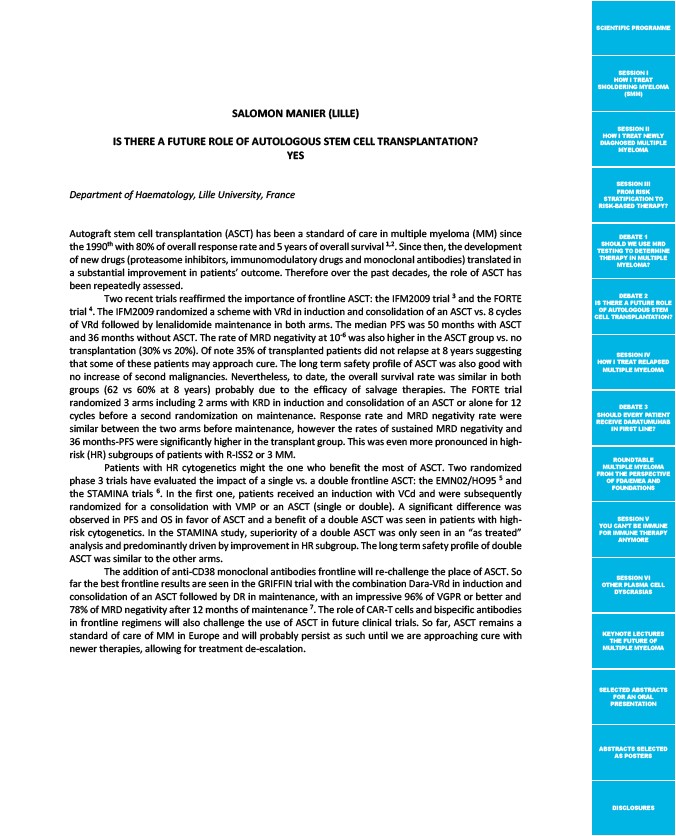
SCIENTIFIC PROGRAMME
SESSION I
HOW I TREAT
SMOLDERING MYELOMA
(SMM)
SESSION II
HOW I TREAT NEWLY
DIAGNOSED MULTIPLE
MYELOMA
SESSION III
FROM RISK
STRATIFICATION TO
RISK-BASED THERAPY?
DEBATE 1
SHOULD WE USE MRD
TESTING TO DETERMINE
THERAPY IN MULTIPLE
MYELOMA?
DEBATE 2
IS THERE A FUTURE ROLE
OF AUTOLOGOUS STEM
CELL TRANSPLANTATION?
SESSION IV
HOW I TREAT RELAPSED
MULTIPLE MYELOMA
DEBATE 3
SHOULD EVERY PATIENT
RECEIVE DARATUMUMAB
IN FIRST LINE?
ROUNDTABLE
MULTIPLE MYELOMA
FROM THE PERSPECTIVE
OF FDA/EMEA AND
FOUNDATIONS
SESSION V
YOU CAN’T BE IMMUNE
FOR IMMUNE THERAPY
ANYMORE
SESSION VI
OTHER PLASMA CELL
DYSCRASIAS
KEYNOTE LECTURES
THE FUTURE OF
MULTIPLE MYELOMA
SELECTED ABSTRACTS
FOR AN ORAL
PRESENTATION
ABSTRACTS SELECTED
AS POSTERS
DISCLOSURES
SALOMON MANIER (LILLE)
IS THERE A FUTURE ROLE OF AUTOLOGOUS STEM CELL TRANSPLANTATION?
YES
Department of Haematology, Lille University, France
Autograft stem cell transplantation (ASCT) has been a standard of care in multiple myeloma (MM) since
the 1990th with 80% of overall response rate and 5 years of overall survival 1,2. Since then, the development
of new drugs (proteasome inhibitors, immunomodulatory drugs and monoclonal antibodies) translated in
a substantial improvement in patients’ outcome. Therefore over the past decades, the role of ASCT has
been repeatedly assessed.
Two recent trials reaffirmed the importance of frontline ASCT: the IFM2009 trial 3 and the FORTE
trial 4. The IFM2009 randomized a scheme with VRd in induction and consolidation of an ASCT vs. 8 cycles
of VRd followed by lenalidomide maintenance in both arms. The median PFS was 50 months with ASCT
and 36 months without ASCT. The rate of MRD negativity at 10-6 was also higher in the ASCT group vs. no
transplantation (30% vs 20%). Of note 35% of transplanted patients did not relapse at 8 years suggesting
that some of these patients may approach cure. The long term safety profile of ASCT was also good with
no increase of second malignancies. Nevertheless, to date, the overall survival rate was similar in both
groups (62 vs 60% at 8 years) probably due to the efficacy of salvage therapies. The FORTE trial
randomized 3 arms including 2 arms with KRD in induction and consolidation of an ASCT or alone for 12
cycles before a second randomization on maintenance. Response rate and MRD negativity rate were
similar between the two arms before maintenance, however the rates of sustained MRD negativity and
36 months-PFS were significantly higher in the transplant group. This was even more pronounced in high-risk
(HR) subgroups of patients with R-ISS2 or 3 MM.
Patients with HR cytogenetics might the one who benefit the most of ASCT. Two randomized
phase 3 trials have evaluated the impact of a single vs. a double frontline ASCT: the EMN02/HO95 5 and
the STAMINA trials 6. In the first one, patients received an induction with VCd and were subsequently
randomized for a consolidation with VMP or an ASCT (single or double). A significant difference was
observed in PFS and OS in favor of ASCT and a benefit of a double ASCT was seen in patients with high-risk
cytogenetics. In the STAMINA study, superiority of a double ASCT was only seen in an “as treated”
analysis and predominantly driven by improvement in HR subgroup. The long term safety profile of double
ASCT was similar to the other arms.
The addition of anti-CD38 monoclonal antibodies frontline will re-challenge the place of ASCT. So
far the best frontline results are seen in the GRIFFIN trial with the combination Dara-VRd in induction and
consolidation of an ASCT followed by DR in maintenance, with an impressive 96% of VGPR or better and
78% of MRD negativity after 12 months of maintenance 7. The role of CAR-T cells and bispecific antibodies
in frontline regimens will also challenge the use of ASCT in future clinical trials. So far, ASCT remains a
standard of care of MM in Europe and will probably persist as such until we are approaching cure with
newer therapies, allowing for treatment de-escalation.